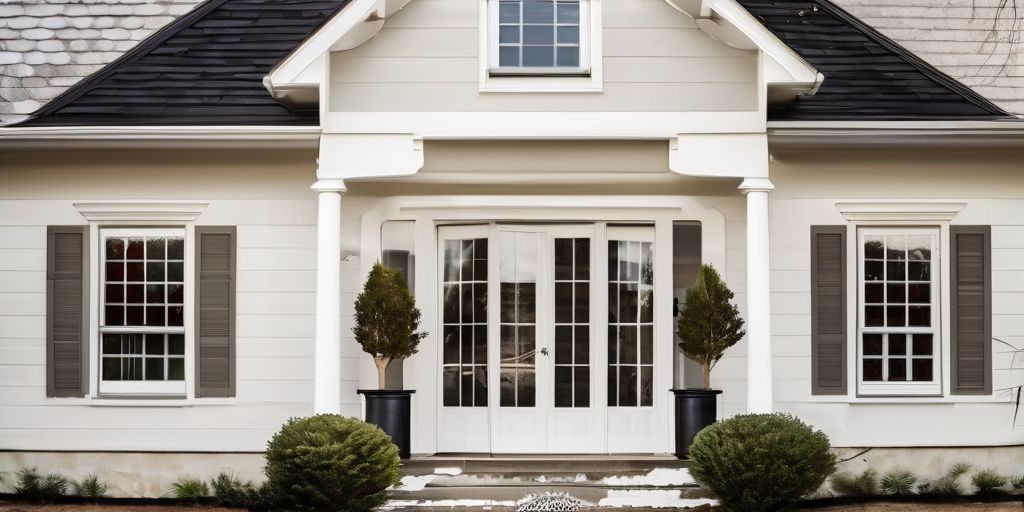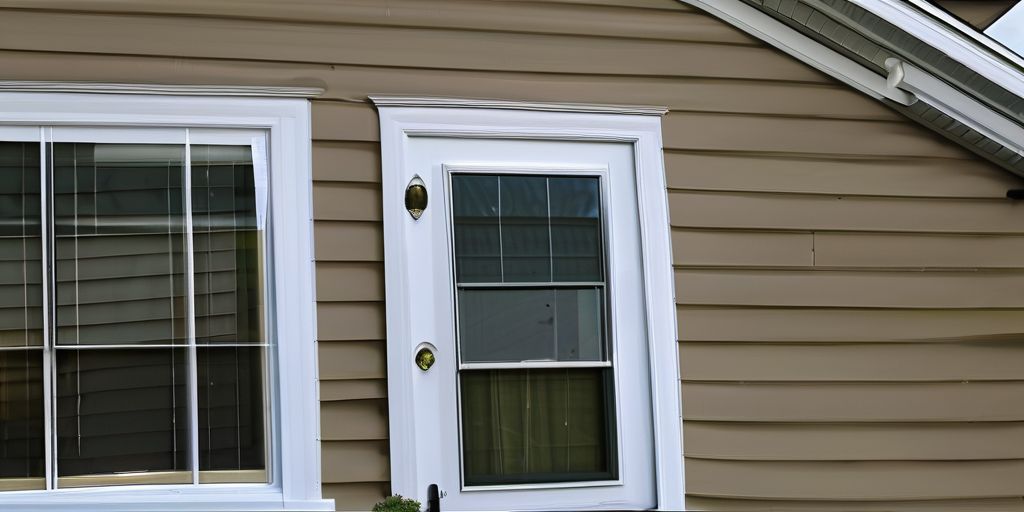Painting vinyl siding can give your home a fresh look without the cost of replacing the siding. However, it’s important to follow the right steps to ensure a long-lasting and professional finish. From preparing the surface to selecting the right paint and tools, each step is crucial. This article will guide you through the process and help you avoid common mistakes.
Key Takeaways
- Clean the vinyl siding thoroughly before painting to ensure the paint adheres well.
- Always use paint specifically designed for vinyl siding to avoid peeling and cracking.
- Avoid painting in extreme weather conditions like high heat, humidity, or wind.
- Protect areas you don’t want to paint by using painter’s tape and plastic sheeting.
- Store leftover paint in a climate-controlled area for future touch-ups.
Preparing Vinyl Siding for Painting
Before you start painting, it’s important to prepare your vinyl siding properly. This ensures the paint adheres well and lasts longer. Here are the steps to get your siding ready for a fresh coat of paint.
Cleaning the Siding
Start by cleaning the siding thoroughly. You can use a pressure washer or a soft brush with soapy water. Make sure to rinse well and let the siding dry completely. This step removes dirt and debris, which can prevent the paint from sticking.
Repairing Damaged Areas
Inspect the siding for any damage. Look for cracks, holes, or loose pieces. Repair these areas to create a smooth surface for painting. Proper surface preparation is crucial for a good finish.
Sanding Rough Spots
After cleaning and repairing, sand any rough spots on the siding. This helps to create a smooth surface that the paint can adhere to better. Use fine-grit sandpaper for the best results.
Taking the time to prepare your vinyl siding will make a big difference in the final look and durability of your paint job.
Choosing the Right Paint for Vinyl Siding
Types of Paint Suitable for Vinyl
When selecting paint for vinyl siding, it’s crucial to choose a high-quality exterior paint specifically formulated for vinyl surfaces. These paints are designed to handle the expansion and contraction of vinyl due to temperature changes. Acrylic latex paint is often recommended because of its durability and excellent adhesion properties. Look for paints labeled as “vinyl-safe” to ensure the best results.
Color Considerations
Choosing the right color is also essential. Darker colors absorb more heat, which can cause the vinyl to warp or distort. Therefore, it’s advisable to opt for lighter shades, especially for south-facing sides of your home. Lighter colors not only help in maintaining the structural integrity of the siding but also enhance the overall appearance.
Primer Necessities
Most advanced paints come as paint-and-primer in one, which can save you an extra step. However, if you opt for a separate primer, make sure it is compatible with vinyl surfaces. A good primer will improve the paint’s adhesion and longevity, ensuring a smooth and durable finish.
Best Weather Conditions for Painting
When planning to paint your vinyl siding, it’s crucial to consider the weather. The right conditions can make a big difference in the outcome of your project. Here are some tips to help you choose the best weather for painting.
Avoiding Extreme Temperatures
Ideal painting conditions are dry and mild. Aim for temperatures between 50°F and 85°F. Painting in very cold or hot weather can cause the paint to dry too quickly or not adhere properly. Always check the weather forecast to avoid unexpected changes.
Humidity Levels
High humidity can affect the drying process and the overall finish of the paint. It’s best to paint on days with low humidity to ensure a smooth and even coat. If the humidity is too high, the paint may not dry correctly, leading to a poor finish.
Windy Days
Avoid painting on windy days. Wind can blow dirt and debris onto the wet paint, ruining the finish. Additionally, wind can cause the paint to dry unevenly. Choose a calm day to ensure the best results.
Remember, the success of your painting project is highly dependent on the weather. Monitoring the weather ensures that your paint job will be both beautiful and long-lasting.
Common Mistakes to Avoid
When painting vinyl siding, there are several common mistakes that can lead to less-than-ideal results. Avoiding these pitfalls will help ensure a smooth and professional finish.
Skipping Surface Preparation
One of the biggest mistakes is not properly preparing the surface. This includes cleaning the siding thoroughly and repairing any damaged areas. Dirt, grime, and damage can prevent the paint from adhering properly, leading to peeling and flaking.
Using Incorrect Paint
It’s crucial to use the right type of paint for vinyl siding. Using the wrong paint can result in poor adhesion and a finish that doesn’t last. Always choose a paint specifically formulated for vinyl.
Over-Applying Paint
Applying too much paint at once can cause drips and an uneven finish. It’s better to apply multiple thin coats rather than one thick coat. This ensures even coverage and a smoother appearance.
Take your time and don’t rush the process. Patience is key to achieving a professional-looking finish.
Avoiding Extreme Temperatures
Painting in extreme weather conditions, such as very hot or cold temperatures, can affect the paint’s performance. Aim to paint on mild days with low humidity for the best results.
Not Protecting Surrounding Areas
Failing to protect areas around the siding can lead to unwanted paint splatters. Use painter’s tape and plastic sheeting to cover windows, doors, and any other surfaces you don’t want to paint.
Improper Storage of Leftover Paint
After painting, store any leftover paint in a climate-controlled area. Use an airtight container to keep the paint fresh for future touch-ups. Proper storage ensures the paint remains usable and matches the original color when you need it.
By avoiding these common mistakes, you can achieve a beautiful and long-lasting finish on your vinyl siding.
Techniques for Painting Vinyl Siding
Painting vinyl siding can be a rewarding DIY project if done correctly. Here are some techniques to help you achieve a professional finish.
Using a Paint Sprayer
A paint sprayer can save you time and provide a smooth, even coat. Start by practicing on a piece of cardboard to get a feel for the sprayer. Hold the sprayer about 12 inches from the surface and move it in a steady, horizontal motion. Overlap each pass slightly to avoid streaks.
Applying Paint with a Roller
For those who prefer a more hands-on approach, a roller is a great option. Use a roller with a 3/8-inch nap for the best results. Apply the paint in thin, even layers, working in small sections. This helps to prevent drips and ensures a uniform finish.
Cutting In Around Edges
Cutting in is essential for a clean look. Use a high-quality brush to paint around windows, doors, and other edges. Dip the brush lightly into the paint and apply it in smooth, even strokes. This technique helps to create a crisp, professional edge.
Remember, taking your time and using the right tools can make a big difference in the final result. Happy painting!
Protecting Surrounding Areas
When painting vinyl siding, it’s crucial to protect the areas around your work zone. Proper preparation can save you from a lot of cleanup later on. Here are some tips to help you keep everything neat and tidy:
Using Painter’s Tape
- Apply painter’s tape around windows, doors, and trim to keep these areas free from paint.
- Make sure the tape is firmly pressed down to prevent any paint from seeping through.
Covering with Plastic Sheeting
- Use plastic sheeting or drop cloths to cover plants, landscaping, and other surfaces near your house.
- Secure the sheeting with weights or tape to keep it in place, especially on windy days.
Shielding Plants and Furniture
- Move any outdoor furniture away from the painting area or cover it with plastic sheeting.
- Protect plants by covering them with lightweight cloths or plastic. This will prevent any paint drips or overspray from damaging them.
Taking the time to protect your surroundings will make your painting project go more smoothly and help you avoid any unwanted messes.
Storing Leftover Paint
Choosing the Right Container
To maintain paint quality, store your leftover paint in a dry, cool place away from direct sunlight and temperature changes. Use airtight containers to prevent the paint from drying out. Avoid using containers that are not specifically designed for paint storage as they may not seal properly.
Climate-Controlled Storage
Properly store leftover paint for touch-ups in a climate-controlled area of your home. This helps in maintaining the paint’s consistency and color. Avoid storing paint in areas prone to extreme temperatures, such as garages or sheds.
Labeling for Future Use
Label each container with the paint color, date of purchase, and the room or area where it was used. This makes it easier to find the right paint for future touch-ups. Use waterproof markers to ensure the labels remain legible over time.
Proper storage of leftover paint ensures you have the right color for touch-ups and helps in reducing waste.
Got leftover paint? Don’t let it go to waste! Store it properly to keep it fresh for future touch-ups. Make sure the lid is sealed tight and keep the can in a cool, dry place. For more handy tips and tricks, visit our website today!
Conclusion
Painting vinyl siding can be a rewarding project if you follow the right steps and avoid common mistakes. Remember to clean the surface thoroughly, choose the right paint, and apply it under suitable weather conditions. With a bit of patience and attention to detail, you can give your home a fresh, new look that lasts. Happy painting!
Frequently Asked Questions
How do you prepare vinyl siding for painting?
Start by cleaning the vinyl siding thoroughly with soapy water and a soft brush or pressure washer. Rinse it well and let it dry completely. Check for any damage and fix it. Sand any rough spots to make them smooth.
What kind of paint should I use on vinyl siding?
Use paint that is made for vinyl siding. This type of paint is flexible and can handle the expansion and contraction of vinyl. You might also need a primer if the paint you choose requires it.
Is it a bad idea to paint vinyl siding?
Painting vinyl siding is not a bad idea if done correctly. It can make your home look new and protect the siding. Just make sure to use the right paint and follow all the steps for preparation and application.
What are common mistakes to avoid when painting vinyl siding?
Avoid common mistakes like not cleaning or repairing the siding before painting, using the wrong type of paint, painting in bad weather, and over-applying the paint. Also, remember to protect the areas around the siding and store leftover paint properly.
Can I paint vinyl siding in any weather?
No, you should avoid painting in extreme temperatures, high humidity, or windy conditions. The best weather for painting is mild, with temperatures between 50°F and 85°F, and low humidity.
How should I store leftover paint?
Store leftover paint in an airtight container in a climate-controlled area. Label the container with the paint color and date for future use.





